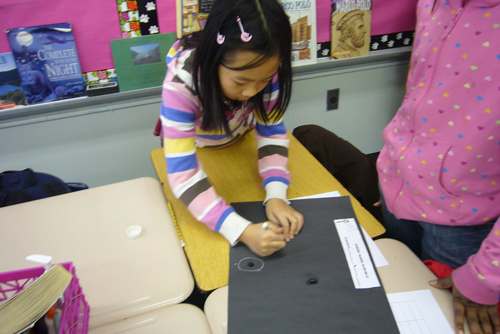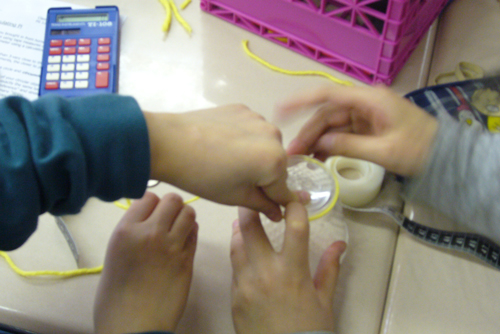Sir Cumference and the Dragon of Pi
| Name: |
Nancy Augello-Rastetter |
| School: |
PS 124 The Yung Wing School |
| Address: |
40 Division Street |
| City: |
New York, NY, 10038 |
| Original Project: |
Sir Cumference and the Dragon of Pi |
| Author: |
Tracee Sudyka |
| URL: |
http://teachersnetwork.org/teachnet-lab/santab2003/tnetarchive/Tracee/pie/pi_index.htm |
How did you modify this unit for use in your own classroom?: Since Pi day promotes the celebration of math, I decided to dedicate an entire week to various math and non-math activities involving Pi. Day 1 Since March 14th (Pi Day) fell on a Friday, we began the week with a shared reading of the book Circumference and the Dragon of Pi by Cindy Neuschwander. Initial concepts were introduced involving math vocabulary. This included discussion of circumference, diameter, radius and pi. Students then investigated some ideas about circles by measuring the distance around several circular objects. They recorded their findings in their math notebooks. They also used a calculator to divide the circumference by the diameter. Day 2 Using the Pi symbol, students made Pi Day decorations. For homework, students brought in 4 circular objects from home to measure. With partners, students kept track of each object's measurements in a chart. They used string, rulers and calculators. Day 3 Since Albert Einstein’s 129th birthday was the same day as Pi day, during shared reading, students learned about his life and contributions including his Theory of Relativity. For homework, students were asked to create a list in which they could think of as many words as they could that began with the letters Pi___. Some words included: Pizarro, pineapple, pinecone, pipe and picket. The book I read aloud was Did it Take Creativity to Find Relativity, Albert Einstein? Students also received a handout of Einstein quotes which they were asked to interpret. Day 4 We shared spelling lists and combined all of the words to create a long list of over 100 words! We also discussed Einstein’s quotes. Day 5 Celebration Day!!! In the morning we did a bubble activity during math. Students blew 5 bubbles, one at at time, directly onto a sheet of black construction paper. After each bubble “popped” on the paper, students outlined in white crayon the circumference of each bubble. Students then compared the area of each bubble. (see attached) Parents made pie donations. Parents, administrators and other teachers were invited to join us in singing happy birthday to Albert Einstein and for some pie-eating. It was indeed a fun celebration!
List your primary instructional objectives for your students.
| |
Students will understand the concept known as Pi. |
| |
Students will estimate and calculate the circumference and the area of circles. |
| |
Students will become familiar with geometry vocabulary. |
| |
Students will differentiate between and use appropriate units of measure. |
What role did technology play in this curriculum unit?: Students learned about Albert Einstein by researching online at http://albert-einstein.org/.index6.html. Students also played a fun MATHO game involving geometry at www.aplusmath.com/cgi-bin/games/geomatho
How did you assess and evaluate student performance?: Students performance during the MATHO game was assessed. Student’s work was scored on a 100 point scale. Each illustration was worth 10 points. Also, student work during the bubble activity was recorded and assessed on the attached form. Students calculations were assessed to determine accuracy. I also observed students' measuring techniques and modeled as needed.
Please tell us briefly about your background & teaching experience: Nancy Augello-Rastetter has been an Elementary school teacher for 8 years. Currently, she is teaching a 4th grade Talented and Gifted class at PS 124 in Chinatown. She graduated with a Masters degree from Hunter College.
What are your recommendations for other teachers interested in adapting this unit?: It is a great idea to incorporate knowledge about Albert Einstein. It is a fun time to acknowledge his contributions and celebrate them on his birthday (Pi Day). I recommend that teachers inform parents and include them in on the celebration. Pie donations were plentiful. Also, I want to point out that when students are making their calculations, it is important that they calculate as close to Pi (3.14) as possible. This constitutes accuracy. You will see it is difficult to have exact measurements. If a student’s calculations seem “off”, have them re-measure for accuracy. Lastly, most of the links provided in the original unit were no longer available/accessible.
Samples of Student Projects
| |
Bubble Mania Activity Handout |
| |
 |
| |
AgueloBubble_Mania_Activity_Sheet[1].doc |
| |
Pi Day Activities |
| |
 |
| |
AguelloPi_Day_Math_Activity[1].doc |
| |
Pi Day Celebration - Students working with circles |
| |
 |
| |
|
| |
|
| |
 |
| |
|
| |
Albert Einstein Quotes |
| |
 |
| |
AgueloAlbert_Einstein_Quotes[1].doc |
| |
Happy Pi Day |
| |
 |
| |
|
| |
 |
|